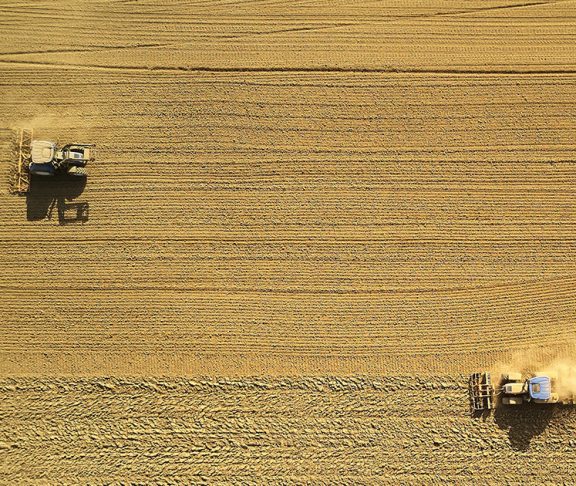The internet of things feels like a far-off concept, but it can be easily implemented into everyday businesses, providing optimization for all.

Adam Wolf
How are your IoT solutions positively impacting your industry?
In order to feed almost 10 billion people by 2050, crop productivity and inputs efficiency will need to increase by farming smarter. Precision agriculture and digital farming empower individual growers to capture incremental improvements and cost savings. With greater insight, growers can do better on all tasks across fields. Producing higher quality foods and better managing our resources provides them a tremendous competitive advantage. With even single-digit increases in yield, we experience compounded growth in profitability; the resulting impact leveraged over 4.62 billion global agricultural acres (USGS 2017) would be profound.
What is one technology trend that your sector should be embracing going into 2019?
Connected Supply Chains for greater efficiency, quality, and traceability. Agricultural enterprises lack visibility into their supply chain, with critical data isolated across diverse departments: planning and management, production and operations, processing and marketing (not to mention the data that remains in silos across businesses or individual growers). These departments are all linked by a common need to know the state of crops growing in the field. A connected supply chain immediately improves traceability and quality throughout this process and solves the issue.
There is a wealth of value locked up inside agricultural enterprises waiting to get out. If only it were placed in the right context with other data, and presented in ways that empower decisions, it could bridge dependencies across various departments, regions and businesses.
How will IoT continue to revolutionize the customer experience?
Our customers are growers, food brands, agribusinesses and technology companies with networks of growers. Growers who learn from digital tools and connected fields are empowered to invest in change that facilitates compounded profitability, leading to more efficient management over expanded acreage. Growers who take a business-as-usual approach lack the evidence to guide future investment and decisions, leading to decreasing margins.
There is also a real desire from the end consumer to connect with the origin of food, ever more sophisticated than “organic” or “local.” Everyone is yearning for there to be greater integrity in the food industry. IoT enables connectivity, traceability and transparency with supply chain ramifications that benefit everyone from our customers to our customers’ customers.
What are some challenges of IoT adoption and how can they be overcome?
Agriculture is the ultimate “old industry.” It is an industry built around individuals with deep experience and outstanding judgment. On one hand, digitizing agriculture means capturing the insights of those professionals. On the other hand, many of those folks are retiring, leaving young professionals with far larger lands to manage. Growers only have so many seasons and approximately 40 harvests to learn, innovate, and cultivate throughout their entire career. There is no way to maintain our current productivity, let alone increase it, in the face of an exodus of expertise, without adding digital tools to monitor, manage, predict and share data. Additionally, with these tools we can capture shared experiences over multiple harvests, whether at one farm over the years or at many farms during one season, amplifying lessons learned across space and time.
In your opinion, which other industries will benefit most from IoT innovation in the near future, and why?
An area of particular interest is insurance. How can you make people bankable, when, in many parts of the world, social media is the only piece information that an insurer has? By characterizing the risk of drought and disease outbreak, suddenly farmers become bankable. This has huge impacts on not only productivity, but also deforestation. For example: the average cacao farm grows a tenth of the best farm, simply because they cannot receive a loan to get inputs. In order to slow deforestation, improve the rate of financial capital. This will increase an ability to buy inputs and instantly intensify production, slowing deforestation.

Charles Egan
How are your IoT solutions positively impacting your industry?
Protecting digital and physical ‘things’ is paramount in today’s hyper-connected world. By protecting IoT endpoints, which should be built with security embedded, not bolted on, businesses and consumers will be able trust the devices that they use and confidently share information without risking security, data privacy and compliance.
What is one technology trend that your sector should be embracing going into 2019?
Organizations need to take a holistic approach to securing all endpoints. Point solutions, not securely connected will lead to higher costs and vulnerability gaps. Most importantly, by not securely connecting endpoints with a horizontal platform that leverages artificial intelligence and machine learning, companies will never create workflows and ultimately realize the benefits of the internet of things.
How will IoT continue to revolutionize the customer experience?
Just how the smartphone revolutionized the way people work and live, the customer experience we know today, whether that’s in a bank or in a car, will dramatically change as more and more connected ‘things’ are built and deployed by public and private sectors.
An example of a highly complex Internet-connected device is a car. Connected vehicles will transform the driving experience with real-time insights and the integration of consumer applications. It will also have a positive impact on society by lowering emissions with reduced traffic and saving lives with advanced driver assistance.
What are some challenges of IoT adoption and how can they be overcome?
The rapid expansion of IoT devices makes cyber intrusion inevitable. If a single endpoint in a smart system is unprotected, the entire system is at risk. It can be managed, but it will require that organizations raise their games in terms of securing every endpoint. Before implementing mobile/IoT security solutions executives should ask these types of questions: Is the solution able to secure, manage, and connect endpoints? Is the solution global? Does my approach include detection, isolation, repair, and response?
In your opinion, which other industries will benefit most from IoT innovation in the near future, and why?
BlackBerry believes the industries that will benefit from IoT the most are ones that focus on security, as we see it being a key differentiator when consumers begin to weigh security and data privacy when purchasing a product and service. An example of an industry that will specifically benefit from IoT innovation is healthcare. By combining the flow of data between clinical, business and building systems with IoT devices, hospitals will realize a new level of care. For instance, a smart bed could send data stating that a bed is below the set minimum angle. This triggers information to be pulled from an electronic medical record, which identifies that the patient has a feeding tube and is at increased risk of aspiration pneumonia because the bed’s position. At this point, a nurse is notified, and the feeding pump would be instructed to stop. This intelligent workflow, is just one of the many ways IoT innovation could transform the healthcare industry.

Kelly Ireland
How are your IoT solutions positively impacting your industry?
CB Technologies is pioneering the journey and transformation of VARs to System Integrators, something that is a requirement today in the new frontier created by IoT. We started down this path over 3 years ago seeing the change on the horizon and knowing that status quo was not a possibility. The VAR industry hasn’t seen this degree of change since its inception several decades ago and for all in this industry it is imperative that they transform. CBT’s early participation has given us the knowledge, real-time experience and thus a platform to showcase the possibilities for others within our industry. The IoT market is expansive with room for those willing to commit to investing in, and nurturing, whichever path or specialization they see fit.
What is one technology trend that your sector should be embracing going into 2019?
The integration of OT (Operation Technology) with IT (Information Technology). The intersection of these two technologies has been around for decades but not to the degree, nor the integration level, that we are seeing today. Previously, IT would always lead solution development/delivery of services supporting the OT side of a business. That has transitioned over the last few years where we are now seeing OT leading, or at least having a significant seat at the table. We have worked with some companies that have gone so far as to remove their IT department from the conversation and found IT-OT integrated solutions via their own paths.
How will IoT continue to revolutionize the customer experience?
There will be continuous enhancements provided with IoT as we have already seen over a short period of time so far. Having ‘everything’ connected provides for an overwhelming number of possibilities as well as the thought of, ‘Is there a tipping point of being too connected?’ This is yet to be answered and I’m sure there will be an intense and inspiring debate over that subject.
There is much to be said though about the IoT revolution and the monumental benefits it can provide. One small example is worker safety. One company that we are partnering with was created out of the experience of having workers never make it home to their families because the work environment just couldn’t be made safe enough. They’ve spent four years and millions of dollars investing in changing this phenomenon. It will not only revolutionize their industry but so many others in the industrial space.
What are some challenges of IoT adoption and how can they be overcome?
The biggest challenge is privacy. For most, it will come down to balancing the benefits gained versus the loss of anonymity. We’ve already seen and heard possible legislation and regulation to protect the rights of individuals. With the vast array of benefits that can be gleaned from these type of solutions, it’s difficult to really know where this will end up. Transparency and education are two of the ways to help overcome the unknown, which tends to be the biggest hindrance to adoption.
In your opinion, which other industries will benefit most from IoT innovation in the near future, and why?
All industries can benefit significantly from IoT. Our industry is impacted because it has basically become our job to deliver on the promise of IoT. But other industries will directly benefit from what we develop in every way imaginable from production, growth, safety, compliance, marketing, HR; the list is expansive.

Jim Heppelmann
How are your IoT solutions positively impacting your industry?
The IoT has revolutionized the way companies conduct business, and industrial enterprises around the world are making huge investments in the Internet of Things and other related technologies. With IoT and digital technologies such as augmented reality (AR), machine learning, cloud analytics, and artificial intelligence, PTC’s manufacturing customers and partners are transforming their businesses into smart, connected enterprises. The world moves fast, and the companies that can shift with it seize a clear advantage. By leveraging IoT and digital technologies, industrial companies can create differentiated products, increase productivity and efficiencies and operate at higher levels of flexibility and agility.
What is one technology trend that your sector should be embracing going into 2019?
Augmented reality. More and more industrial enterprises will adopt AR in 2019 to improve customer experiences, open up new revenue streams, disrupt competition, and change the way a new generation of workers not only learn new skills but, how they create, operate and service products and industrial equipment. Industrial AR reveals a world of opportunity by giving humans the ability to see digital data that would otherwise be invisible. AR creates smart, connected workers, and in industrial settings, transforms the way workers perform their tasks – enabling them to visualize, instruct and interact with things. From those working in production on the factory floor to those in the field at a service call or installation site, AR is changing the way we work.
Whether for enhancing products, services, and solutions offered to customers or to drive operational excellence within the enterprise, AR provides new transformative capabilities that cannot be overlooked. Industrial enterprises should seek partners and technology providers that have solutions ready to deliver value and build augmented reality experiences as quickly and easily as possible.
How will IoT continue to revolutionize the customer experience?
Connected products are already transforming how goods and services are sold to the public, the model under which they are sold, and how they are maintained. The data and capabilities that smart, connected products provide have changed the way companies interact with their customers, allowing for more customized promotions and personalized engagement, which is tailored to the unique customer. It also provides the voice of the product. With IoT, products can now tell its maker if it is experiencing service issues and failing, enabling the maker to address issues before the owner ever knows there is a problem. This transforms the complete customer experience. Complemented with augmented reality technology, products can also now provide more meaningful insights and can provide customers with the ability to visualize a product in a real-life setting, such as a factory floor, at scale. This revolutionizes the customer experience by bringing products to life.
What are some challenges of IoT adoption and how can they be overcome?
Challenges associated with the adoption of IoT include ROI justification, internal/cultural acceptance, misaligned expectations, and mismanagement of the trove of new data. It’s important to realize that the IoT has the potential to transform an organization’s entire strategy. This transformation is shifting the sources of value and differentiation to software, the cloud, and service, while potentially spawning an entirely new business model. Companies have an urgent need to rethink nearly everything — from how products are created, manufactured, sold, operated, and serviced. Those who don’t are placing their current competitive advantage at risk. Those who are able to quickly identify the opportunities IoT provides and deliver market-ready solutions, will share in the value expansion and be the leaders of the next decade. The adoption of IoT must be considered a strategic initiative across the entire enterprise for it to be successful and it also requires strong technology solution partnerships as well as a robust platform.
In your opinion, which other industries will benefit most from IoT innovation in the near future, and why?
Industrial companies have the most to gain from IoT innovation in the coming years. With the implementation of technologies such as augmented reality and IoT, factories have been shown to become more agile, a trait designated as being of the utmost importance for the future of the manufacturing industry. Analyst firm IDC also predicts that companies will spend over $1 trillion on digital transformation, with nearly one-third of that spend in manufacturing where the applications of Internet of Things and augmented reality are changing the way businesses manufacture, operate, and service their products.

